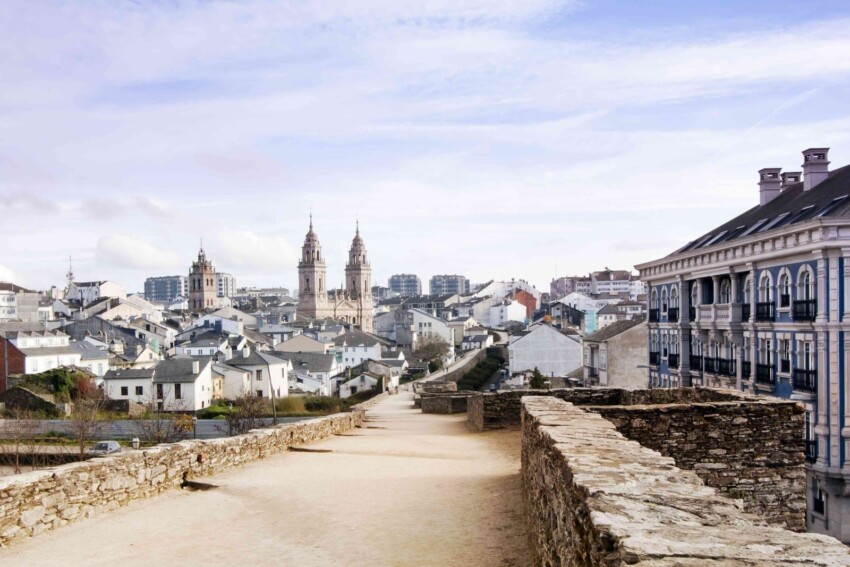

Situated along the banks of the Miño River, Lugo is a town in Galicia famous for its architectural and historical heritage. In fact, the city was founded by the Romans between 26 and 12 B.C. under the name ‘Lucus Augusti’ in honour of the Emperor Augustus. From a small military camp, Lugo later became one of the three administrative capitals of the Gallaecia region.
Numerous signs of Roman times are preserved in the city, including the city walls, which were built between the end of the 3rd and beginning of the 4th century AD and have survived almost intact. Thanks to their state of preservation, these thousand-year-old walls were included in the UNESCO World Heritage List in 2000.
With the end of Roman rule, Lugo became a centre of pilgrimage thanks to the special prerogative granted to its cathedral: that of publicly displaying a consecrated host for all twenty-four hours of the day. This special privilege has made Lugo so famous among Christian pilgrims that the chalice with the host is even present in the city’s coat of arms. Lugo, in fact, was part of the Camino Primitivo, a section of the Camino de Santiago that starts in Oviedo and ends in Lugo.
In addition to the walls, there are also other legacies from the Roman era such as thermal baths and several bridges. In the later period, however, important buildings and sites of interest were built in the city, such as the Cathedral, the Church of San Francisco (today San Pedro), the Archbishop’s Palace and the Town Hall.
The historical centre of the city is enclosed within the Roman walls, while the more modern and recently built part is outside the walls. In the older part, there are pedestrian alleys, small squares and historic buildings. Here you should not miss a visit to the Cathedral and the statue of the Virgen de los Ojos Grandes, (Our Lady of the Big Eyes).
If you are in need of a rest while sightseeing, remember that Lugo boasts some of the best restaurants in Galicia. The suggestion is to sit down at one of the taverns to taste the famous Mencía wine and excellent traditional dishes.
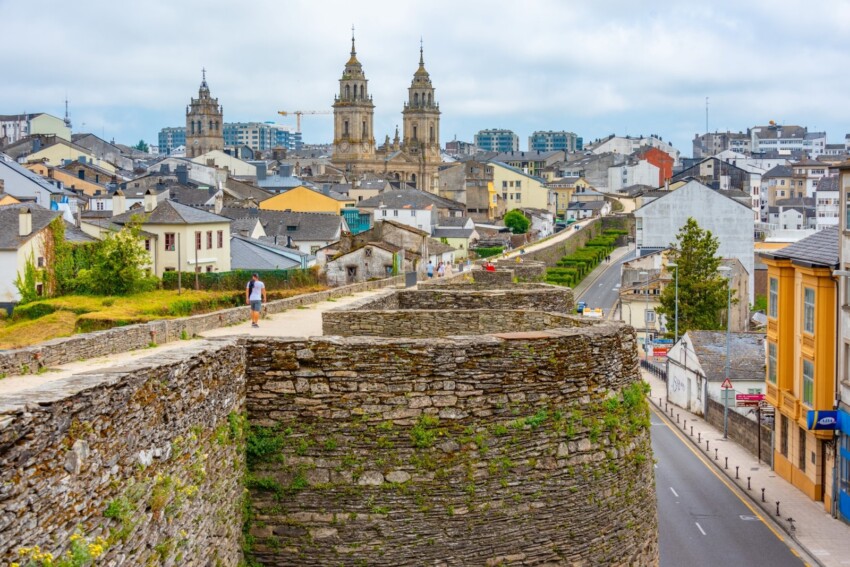
Lugo’s Roman walls were erected to defend the city of Lucus Augusti from barbarian incursions. The quadrangular walls enclosed an area of about 34 hectares and stretched for about 2 km. Their thickness is approximately four metres while their height varies between eight and twelve metres.
The walls are characterised by the presence of 71 two-storey towers (60 circular and 11 square) and the presence of 10 gates that provided access to the city. In reality, half of these gates were opened in the mid-19th century following the expansion of the centre. The Roman walls are one of the most important remains left by the Romans in this region.
Having arrived virtually intact, UNESCO has included them in its list of World Heritage sites. It is possible to admire this architectural masterpiece up close by walking along the roundabout walk, which is approximately two kilometres long and allows you to admire the city and its surroundings from a privileged position.
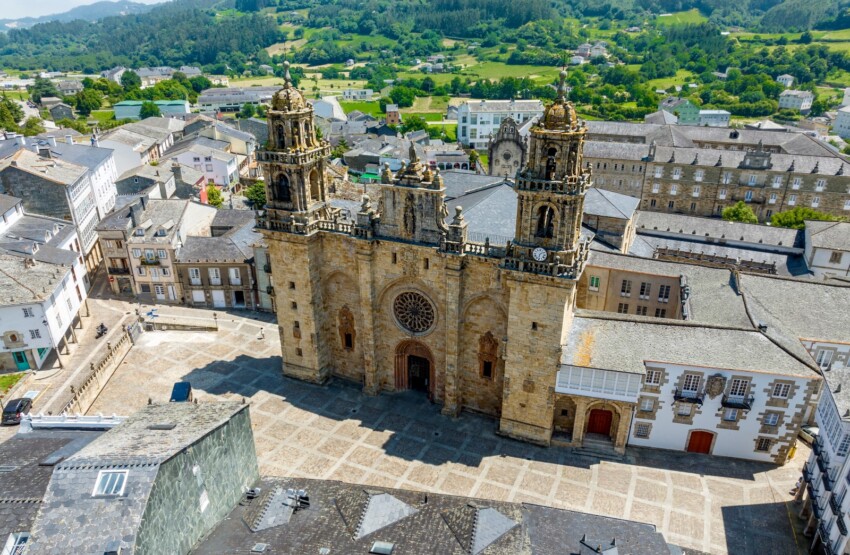
Lugo Cathedral is a religious building that combines different architectural styles ranging from Romanesque to Neoclassical. This fusion is due to the fact that its construction took several years.
The façade we can now admire is neoclassical in style and replaced the previous Romanesque one. The outer doorway is Romanesque with a tympanum housing a Maiestas Domini from the 13th century.
The interior, on the other hand, is characterised by a three-nave plan in Romanesque-Gothic style. It houses the famous image of the Virgen de los Ojos Grand es (Virgin of the Big Eyes), so called because of the expressiveness of her face.
Lugo boasts a famous thermal spa that has been active since Roman times. Near the thermal baths is also the Roman bridge that served as a link between the city and southern Galicia. Thermal baths were part of the lifestyle of the Romans and archaeological excavations carried out have provided various information on the organisation of these public baths.
Of the original structure, some rooms such as the changing room and the room used for cold baths are still visible. Unfortunately, the latter hall was later converted into a Christian chapel and this changed part of its original structure. The Roman Baths are currently located inside the Hotel Balneario de Lugo.
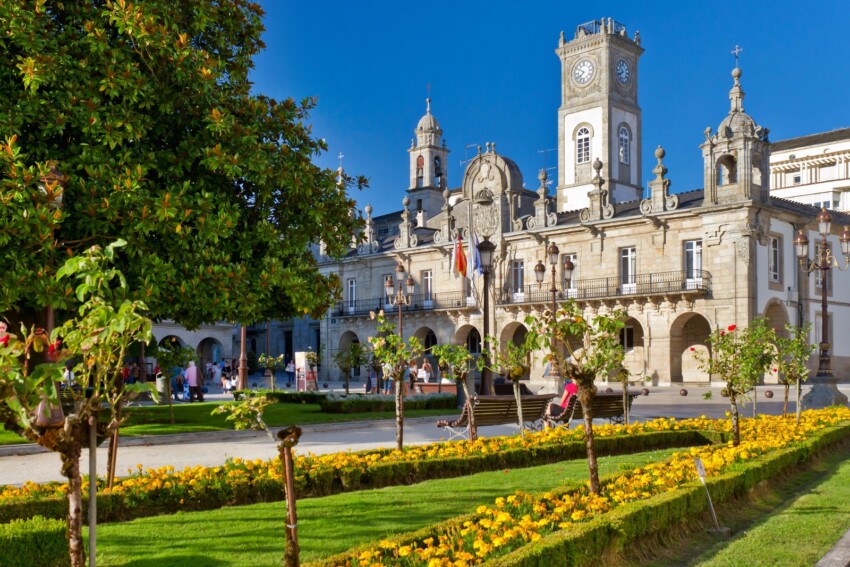
The Plaza Mayor is the beating heart of the old town. Dominated by the majestic 18th-century Town Hall building, the square is surrounded by arcades housing historic cafés and traditional shops. It is the favourite meeting point for the people of Lucerne and the place where the main city events take place. The municipal building, with its characteristic Baroque façade, is a perfect example of 18th century civil architecture.
Praza do Campo is one of the most characteristic squares in the historical centre, formerly used as a market. The square is dominated by the ancient fountain of San Vicente, a landmark for pilgrims on the Pilgrim’s Way to Santiago. Its arcades house some of the city’s most traditional bars and restaurants, where you can sample the renowned Galician cuisine.
The Casa dos Mosaicos is an archaeological site that preserves the remains of a Roman domus with beautiful mosaics from the 3rd century AD. The museum allows visitors to view the original mosaics through a glass floor and understand the organisation of a Roman house. Virtual reconstructions and explanatory panels help visitors imagine daily life in ancient Lucus Augusti.
To learn more about the history and culture of these territories, a visit to the Lugo Museum is recommended. The museum was originally opened in 1934 at the Pazo de San Marcos, but the expansion of the collections forced its relocation in 1957 to the former convent of San Francisco.
Here you can admire numerous exhibits that belong to different historical periods and include works of sacred art, ceramic creations, watches, numismatics and medals. One section of the site is dedicated to Galician art, while another room is used for temporary exhibitions.
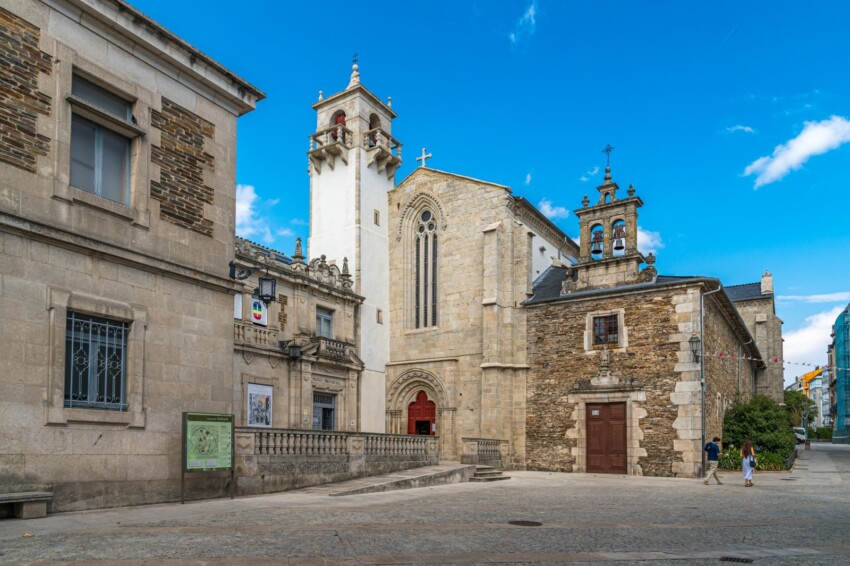
The Church of St. Francis, also known as the Church of San Pedro, is said to have been founded by St. Francis on his way to Santiago. The complex currently comprises the church and the cloister that houses the Lugo Provincial Museum. The church was built in the 15th century in Gothic style and has a Latin cross plan. The cloister, on the other hand, has a square plan and features round arches decorated with plant motifs.
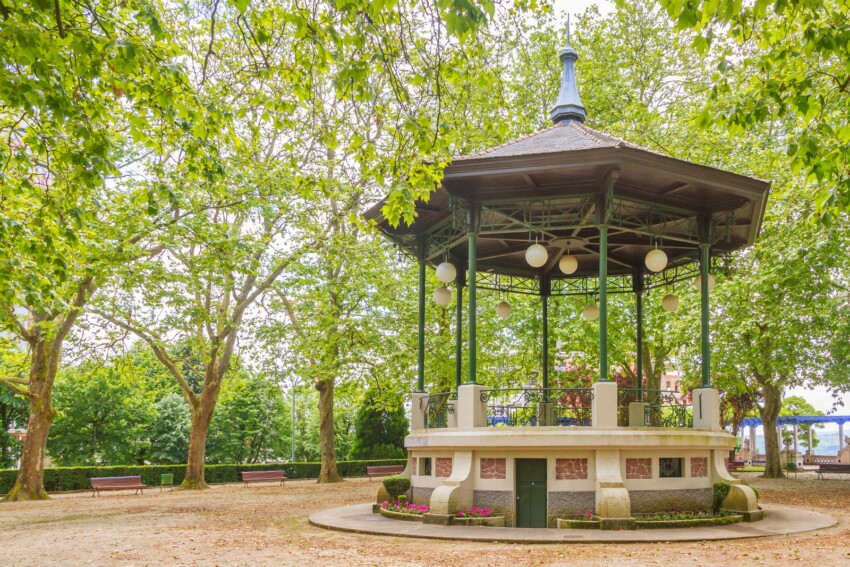
Not far from the historical centre is the Rosalia de Castro Park, which is considered the green lung of the city. Rosalia de Castro was Galicia’s most famous poetess and her favourite flower was the camellia, so much so that it also became Galicia’s symbol flower.
The park covers some 60 acres and is home to a small lake and a children’s play area. The Rosalia de Castro park also contains ancient trees, redwood conifers, magnolias and camellias.
In the following map you can see the location of the main places of interest mentioned in this article.
Being part of the Primitive Way, Lugo is known for its hospitality and the many facilities that are ready to welcome tourists and pilgrims. In the city there are different types of accommodation such as hotels, hostels and inns. The historical centre, within the Roman walls, is the ideal area for accommodation. Boutique hotels housed in old buildings offer an authentic experience in the heart of the historic city, with easy access to all the main monuments.
Lugo can be easily reached by car or public transport. The city is well served by a dense road and motorway network. In particular, the A-8 motorway connects the Autonomous Community of Galicia with the cities of northern Spain; the A-6 motorway, on the other hand, connects the east coast with Madrid via Lugo. Through this it is possible to reach not only the Spanish capital but also cities such as La Coruña. Finally, the AP-9 provides connections with neighbouring Portugal.
Those who want to travel by bus can take the ALSA company’s routes that connect cities such as Madrid, Barcelona and Bilbao with Galicia via Lugo. From Madrid, for example, it is possible to reach Lugo with a journey of around five and a half hours. Lugo also has a railway station that connects the city with the main towns in Galicia and beyond. Lugo can also be reached thanks to three international airports: Santiago de Compostela, which is 90 km away, La Coruña, which is 100 km away and Vigo, which is approximately 180 km away.
What's the weather at Lugo? Below are the temperatures and the weather forecast at Lugo for the next few days.